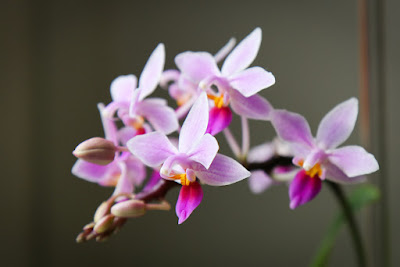The Horse Phalaenopsis is native from the Philippines island of Luzon to Taiwan, at an altitude of 0-300 m, near streams in the hot valleys. It is a small sized, hot growing, monopodial epiphyte with a short stem enveloped by several limbricating leaf bases and carrying to 5, fleshy, recurved, oblong-elliptic to oblong-ovate, acute or subobtuse leaves. The leaves are 15-20 cm long.
Phalaenopsis equestris orchid, also called as The Horse Phalaenopsis, Phalaenopsis equestris f. alba, Phalaenopsis equestris f. aurea, Phalaenopsis equestris f. cyanochila, Phalaenopsis equestris var alba, Phalaenopsis equestris var leucaspis, Phalaenopsis equestris var leucotanthe, Phalaenopsis equestris var. rosea, Phalaenopsis Esmeralda, Phalaenopsis riteiwanensis, Phalaenopsis rosea, Phalaenopsis rosea var aurantiaca, Phalaenopsis rosea var deliciosa, Phalaenopsis rosea var leucaspis, Phalaenopsis stauroglottis, Stauroglottis equestris, Stauroglottis riteiwanensis, is a species of the genus Phalaenopsis. This species was described by (Schauer) Rchb.f in 1849.
IDENTIFY PHALAENOPSIS EQUESTRIS ORCHID
The Horse Phalaenopsis is native from the Philippines island of Luzon to Taiwan, at an altitude of 0-300 m, near streams in the hot valleys.
It is a small sized, hot growing, monopodial epiphyte with a short stem enveloped by several limbricating leaf bases and carrying to 5, fleshy, recurved, oblong-elliptic to oblong-ovate, acute or subobtuse leaves. The leaves are 15-20 cm long.
Flowers are possible at almost any time of the year although the peak is September through April on a suberect to arcuate, to 12" (30 cm) long, racemose or paniculate, densely many flowered inflorescence with small, purple bracts and successive opening flowers. The permanent flowers are 2.5-3.8 cm in diameter. Their size is variable and increases with the prolongation of the flower shoot. Delicate flowers, with external whorls bent backwards, have variable colors. The flowers are usually white, differently colored in pink and may have purple, orange or pink spots. The lip is pink with yellow side plots.
On the inflorescences, keikis often arise, and from the root ball often outgrow lateral growths, which bloom simultaneously with the mother plant. The roots and flower shoots should not be cut off, because over the years they tend to grow and branch.
GROW AND CARE PHALAENOPSIS EQUESTRIS ORCHID
Phalaenopsis equestris orchid is easy to grow and easily adapts to different conditions. On hybrids, it plays an important role in the development of novelty species and it is frequently used to cross with other hybrids. It has become an important commodity in the international floral trade.
Light:
The Horse Phalaenopsis needs light level of 10,000-12,000 lux in the summer and increased to 12000-15000 lux in winter.
Temperature:
It is a thermophilic plant. The average summer temperatures are 29-33 ° C and the average temperatures are 21-23 ° C, with a daily amplitude of 7-10 ° C. In winter, the average daytime temperatures are 29-31 ° C, and the night 19-21 ° C, with a daily amplitude of 9-11 ° C.
Humidity:
This plant need a humidity of 80% or more in summer, but should be reduced to 70-75% in the period 3-4 months of winter.
Substrate and growing media:
It can be mounted on trunks, bark, cork raft or cultivated in pots, also hanging, with much draining and aerated compost which may be formed by 12-16 mm pieces of fir or pine bark, with possible addition of inserts in order to improve the drainage.
Watering:
In spring-summer, during the vegetative period, the waterings must be regular and abundant, but allowing the roots to dry up before giving water again, stagnations at the axil of the leaves are to be avoided, especially during the night and with medium-low temperatures, a constant, good ventilation is fundamental in order to prevent rottenness. Rainwater, or water obtained by reverse osmosis or demineralized is recommended.
Fertilizer:
In the period of active growth, it is recommended to apply once a week or once every two weeks 1/4-1/2 of the recommended dose of fertilizer for orchids.
Rest period and repotting:
Water should reduced in winter in way to grant the plant a period of rest, the humidity should be reduced to 70-75%, reduced fertilization, and light level increased to 12000-15000 lux.
Plants are best repotted immediately after flowering, or when the growth of new roots begins.















COMMENTS